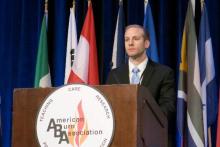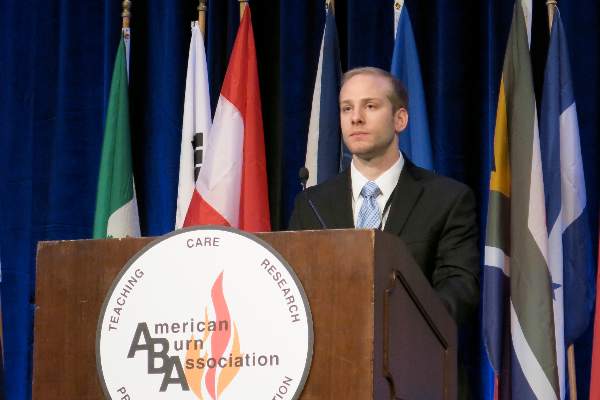User login
CHICAGO – Adult survivors of childhood burns have significantly higher rates of Axis I mental and physical disorders years after their injury, a population-based study shows.
“We think it is really important to screen for, identify, and treat these illnesses not only in that acute period and shortly after the burn injury, but well into adulthood,” study author James Stone said at the annual meeting of the American Burn Association.
He reported on 745 adult burn survivors identified using administrative data from a regional pediatric burn center registry in Manitoba, Canada, who were matched 1:5 with 3,725 controls from the general Manitoba population based on age, sex, and geographic location. The burn survivors had an average age of 5.9 years at the time of burn injury, burns involved an average 12% of total body surface area, and 65% of burn survivors were male. The average follow-up was nearly 15 years (range 2.8-24.7 years).
In unadjusted univariate analysis, adult survivors had significantly higher rates than matched controls for any lifetime physical disorder (rate ratio, 1.17), arthritis (RR, 1.23), cancer (RR, 1.94), diabetes (RR, 1.69), fractures (RR, 1.45), and total respiratory morbidity (RR, 1.15).
After adjustment for gender, geography, and income, any physical disorder (RR, 1.15; P value < .01), arthritis (RR, 1.24; P < .01), fractures (RR, 1.37; P .001), and total respiratory morbidity (RR, 1.13; P < .05) remained significant, Mr. Stone, from the University of Manitoba, Winnipeg, Canada, reported.
Further, 81% of burn survivors had a lifetime physical illness compared with 69% of controls.
“The fact that 81% of our burn cohort was diagnosed with a physical illness is definitely concerning,” he said. “We hypothesize that the prolonged hyperinflammatory and hypermetabolic state that has been previously reported makes these individuals more susceptible to these illnesses down the road.”
The burn cohort also had significantly higher unadjusted rate ratios for any Axis 1 mental disorder (RR, 1.62), major depressive disorder (RR, 1.64), anxiety (RR, 1.57), substance abuse (RR, 2.86), and suicide attempts (RR, 5.00).
All disorders remained statistically significant after adjustment with rate ratios of 1.54 (P < .001), 1.54 (P < .001), 1.50 (P < .001), 2.35 (P < .001), and 4.33 (P < .01), respectively.
The high rates of substance abuse and suicide attempts are consistent with previous clinical interview studies, but are still cause for great concern, Mr. Stone said.
The risk for any mental or physical disorder was not significantly impacted by burn location or by burns that affected more than 30% of total body surface area. Age older than 5 years at the time of the burn significantly increased the risk of any mental disorder (relative risk, 1.92; P < .001).
Limitations of the study include the potential for bias because the data relied on individuals presenting to physicians, discrepancies between ICD codes for physician billings and hospital claims, and some survivors may have moved out of the province, Mr. Stone said. The study, however, had a sample size three times greater than the next largest study of its kind, and importantly, matched burn patients to the general population.
CHICAGO – Adult survivors of childhood burns have significantly higher rates of Axis I mental and physical disorders years after their injury, a population-based study shows.
“We think it is really important to screen for, identify, and treat these illnesses not only in that acute period and shortly after the burn injury, but well into adulthood,” study author James Stone said at the annual meeting of the American Burn Association.
He reported on 745 adult burn survivors identified using administrative data from a regional pediatric burn center registry in Manitoba, Canada, who were matched 1:5 with 3,725 controls from the general Manitoba population based on age, sex, and geographic location. The burn survivors had an average age of 5.9 years at the time of burn injury, burns involved an average 12% of total body surface area, and 65% of burn survivors were male. The average follow-up was nearly 15 years (range 2.8-24.7 years).
In unadjusted univariate analysis, adult survivors had significantly higher rates than matched controls for any lifetime physical disorder (rate ratio, 1.17), arthritis (RR, 1.23), cancer (RR, 1.94), diabetes (RR, 1.69), fractures (RR, 1.45), and total respiratory morbidity (RR, 1.15).
After adjustment for gender, geography, and income, any physical disorder (RR, 1.15; P value < .01), arthritis (RR, 1.24; P < .01), fractures (RR, 1.37; P .001), and total respiratory morbidity (RR, 1.13; P < .05) remained significant, Mr. Stone, from the University of Manitoba, Winnipeg, Canada, reported.
Further, 81% of burn survivors had a lifetime physical illness compared with 69% of controls.
“The fact that 81% of our burn cohort was diagnosed with a physical illness is definitely concerning,” he said. “We hypothesize that the prolonged hyperinflammatory and hypermetabolic state that has been previously reported makes these individuals more susceptible to these illnesses down the road.”
The burn cohort also had significantly higher unadjusted rate ratios for any Axis 1 mental disorder (RR, 1.62), major depressive disorder (RR, 1.64), anxiety (RR, 1.57), substance abuse (RR, 2.86), and suicide attempts (RR, 5.00).
All disorders remained statistically significant after adjustment with rate ratios of 1.54 (P < .001), 1.54 (P < .001), 1.50 (P < .001), 2.35 (P < .001), and 4.33 (P < .01), respectively.
The high rates of substance abuse and suicide attempts are consistent with previous clinical interview studies, but are still cause for great concern, Mr. Stone said.
The risk for any mental or physical disorder was not significantly impacted by burn location or by burns that affected more than 30% of total body surface area. Age older than 5 years at the time of the burn significantly increased the risk of any mental disorder (relative risk, 1.92; P < .001).
Limitations of the study include the potential for bias because the data relied on individuals presenting to physicians, discrepancies between ICD codes for physician billings and hospital claims, and some survivors may have moved out of the province, Mr. Stone said. The study, however, had a sample size three times greater than the next largest study of its kind, and importantly, matched burn patients to the general population.
CHICAGO – Adult survivors of childhood burns have significantly higher rates of Axis I mental and physical disorders years after their injury, a population-based study shows.
“We think it is really important to screen for, identify, and treat these illnesses not only in that acute period and shortly after the burn injury, but well into adulthood,” study author James Stone said at the annual meeting of the American Burn Association.
He reported on 745 adult burn survivors identified using administrative data from a regional pediatric burn center registry in Manitoba, Canada, who were matched 1:5 with 3,725 controls from the general Manitoba population based on age, sex, and geographic location. The burn survivors had an average age of 5.9 years at the time of burn injury, burns involved an average 12% of total body surface area, and 65% of burn survivors were male. The average follow-up was nearly 15 years (range 2.8-24.7 years).
In unadjusted univariate analysis, adult survivors had significantly higher rates than matched controls for any lifetime physical disorder (rate ratio, 1.17), arthritis (RR, 1.23), cancer (RR, 1.94), diabetes (RR, 1.69), fractures (RR, 1.45), and total respiratory morbidity (RR, 1.15).
After adjustment for gender, geography, and income, any physical disorder (RR, 1.15; P value < .01), arthritis (RR, 1.24; P < .01), fractures (RR, 1.37; P .001), and total respiratory morbidity (RR, 1.13; P < .05) remained significant, Mr. Stone, from the University of Manitoba, Winnipeg, Canada, reported.
Further, 81% of burn survivors had a lifetime physical illness compared with 69% of controls.
“The fact that 81% of our burn cohort was diagnosed with a physical illness is definitely concerning,” he said. “We hypothesize that the prolonged hyperinflammatory and hypermetabolic state that has been previously reported makes these individuals more susceptible to these illnesses down the road.”
The burn cohort also had significantly higher unadjusted rate ratios for any Axis 1 mental disorder (RR, 1.62), major depressive disorder (RR, 1.64), anxiety (RR, 1.57), substance abuse (RR, 2.86), and suicide attempts (RR, 5.00).
All disorders remained statistically significant after adjustment with rate ratios of 1.54 (P < .001), 1.54 (P < .001), 1.50 (P < .001), 2.35 (P < .001), and 4.33 (P < .01), respectively.
The high rates of substance abuse and suicide attempts are consistent with previous clinical interview studies, but are still cause for great concern, Mr. Stone said.
The risk for any mental or physical disorder was not significantly impacted by burn location or by burns that affected more than 30% of total body surface area. Age older than 5 years at the time of the burn significantly increased the risk of any mental disorder (relative risk, 1.92; P < .001).
Limitations of the study include the potential for bias because the data relied on individuals presenting to physicians, discrepancies between ICD codes for physician billings and hospital claims, and some survivors may have moved out of the province, Mr. Stone said. The study, however, had a sample size three times greater than the next largest study of its kind, and importantly, matched burn patients to the general population.
AT THE ABA ANNUAL MEETING
Key clinical point: Adult survivors of childhood burn injuries have increased rates of Axis I mental and physical disorders.
Major finding: 81% of burn survivors had a physical disorder vs. 69% of matched controls.
Data source: Population-based study in 745 adult survivors of childhood burns.
Disclosures: The study was funded by grants from the University of Manitoba and the Manitoba Firefighters Burn Fund. The authors declared no conflicts of interest.

